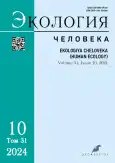Исследование влияния сезонных факторов на показатели частоты сердечных сокращений и сегмента ТР ЭКГ у подростков в условиях Европейского Севера
- Авторы: Русских Н.Г.1, Осколкова Е.М.2, Иржак Л.И.1
-
Учреждения:
- Сыктывкарский государственный университет им. Питирима Сорокина
- Коми Республиканский лицей при Сыктывкарском государственном университете
- Выпуск: Том 31, № 10 (2024)
- Страницы: 730-737
- Раздел: ОРИГИНАЛЬНЫЕ ИССЛЕДОВАНИЯ
- URL: https://journal-vniispk.ru/1728-0869/article/view/314550
- DOI: https://doi.org/10.17816/humeco643381
- EDN: https://elibrary.ru/SKMKHB
- ID: 314550
Цитировать
Полный текст
Аннотация
Обоснование. Жители, проживающие в условиях резко-континентального климата Европейского Севера, вырабатывают специфические механизмы адаптации к значительным сезонным колебаниям температуры и другим метеорологическим параметрам. Анализ индивидуальных реакций сердца на эти сезонные изменения является ключевым для понимания физиологических стратегий выживания и адаптации в экстремальных климатических условиях.
Цель. На основании показателей частоты сердечных сокращений и длительности сегмента ТР определить соотношения между частотно-временными показателями работы сердца в январе и мае у подростков 15–16 лет, проживающих в Сыктывкаре.
Материалы и методы. У 22 подростков 15–16 лет в положении стоя и в ответ на клиностатическую пробу в январе и мае проводили запись ЭКГ во II стандартном отведении. На основе записи 20 кардиоциклов определяли частоту сердечных сокращений и длительность сегмента ТР. Статистическую обработку материала выполняли с помощью пакета программы Excel.
Результаты. Анализ средних групповых данных по частоте сердечных сокращений и длительности сегмента ТР не выявил статистически значимых сезонных различий. Более глубокий анализ индивидуальных данных продемонстрировал существенные сезонные колебания как частоты сердечных сокращений, так и длительности сегмента ТР. В зимний период наблюдались более выраженные сдвиги частоты сердечных сокращений в ответ на клиностатическую пробу, достигающие 39%, по сравнению с маем (максимальный сдвиг — 23%). Аналогичная тенденция прослеживалась и для длительности сегмента ТР. Индивидуальный подход продемонстрировал различные сдвиги как частоты сердечных сокращений, так и длительности сегмента ТР у значительной части обследуемых в разные сезоны года.
Заключение. Подтверждена необходимость индивидуального подхода к оценке реакции на сезонные факторы среды.
Полный текст
Открыть статью на сайте журналаОб авторах
Надежда Геннадьевна Русских
Сыктывкарский государственный университет им. Питирима Сорокина
Автор, ответственный за переписку.
Email: rung76@mail.ru
ORCID iD: 0000-0003-4413-8258
SPIN-код: 1240-4336
канд. биол. наук, доцент
Россия, 167005, Сыктывкар, ул. Петрозаводская, д. 21–142Елена Михайловна Осколкова
Коми Республиканский лицей при Сыктывкарском государственном университете
Email: v.oskolkova@mail.ru
SPIN-код: 2922-7958
канд. биол. наук, доцент
Россия, СыктывкарЛев Исакович Иржак
Сыктывкарский государственный университет им. Питирима Сорокина
Email: irzhak31@mail.ru
ORCID iD: 0000-0003-3459-7848
SPIN-код: 1156-8956
д-р биол. наук, профессор
Россия, СыктывкарСписок литературы
- Kandror IS. The effect of the polar day and polar night on the human organism under condinions of large settlements. Gig Sanit. 1958;23(5):7–13.
- Irzhak LI, Russkikh NG, Gudkov AB. Analysis of the correlations between ECG components in adolescents both before and after exposure to different types of physical stress in the Subarctic winter conditions. Ekologiya cheloveka (Human Ecology). 2023;30(12):891–900. doi: 10.17816/humeco626830 EDN: JHKGQD
- Russkikh NG, Irzhak LI. Variability of electrocardiogram elements in 6–7-year-old children under the influence of physical activity in the conditions of the European North. Ekologiya cheloveka (Human Ecology). 2018;25(10):32–38. doi: 10.33396/1728-0869-2018-10-32-38 EDN: YLBXOP
- Dernovoy BF, Prosheva VI. The cardiovascular system under conditions of changing hemodynamic load in humans in the North. Syktyvkar: Komi nauchnyi tsentr Ural'skogo otdeleniya; 2024. 168 р. EDN: MCMGDM
- Varlamova NG. Annual cycles of cardiorespiratory function in humans in the European North [dissertation]. Syktyvkar; 2020. 280 р. (In Russ.) EDN: GIKMYP
- Povzun VD, Povzun AA. Seasonal changes in the functional state of the cardiovascular system in female students with different levels of physical activity. Theory and Practice of Physical Culture. 2021;(11):53–55. EDN: ZPVCRZ
- Tolstov PV, Kalyagin AN, Tatarinova MB. Influence of heliogeophysical and climatic factors on the cardiovascular system: a literature review. Cardiovascular Therapy and Prevention. 2023;22(8):92–102. doi: 10.15829/1728-8800-2023-3599 EDN: TTOLAW
- Ignatova AN, Parshukova EA, Oskalenko AM, et al. Corrected QT interval of the electrocardiogram in the prone position in young and healthy men. Russian Journal of Cardiology. 2024;29(S7):17–18. (In Russ.) EDN: VFCPCE
- Irzhak LI, Russkikh NG, Parshukova AN. Variability of time and amplitude ecg indicators in older adults. Journal of Medical and Biological Research. 2021;9(4):355–365. doi: 10.37482/2687-1491-Z073 EDN: CTACMJ
- Irzhak LI, Russkikh NG, Ignatova AN. Correlations between rhythmic activity parameters of the human heart. Journal of Medical and Biological Research. 2024;12(2):172–180. doi: 10.37482/2687-1491-Z192 EDN: LUFMJM
- Dudnikova EA, Gerasimenko MV. Temporal relation of ecg elements and cardiac rhythm at rest. In the World of Scientific Discoveries. 2016;(3):101–113. doi: 10.12731/wsd-2016-3-8 EDN: VUZRYH
- Solonin YuG, Markov AL, Bojko ER. The longitudinal study results of the physiological status of male northerners - participants of the project "Mars-500". Ekologiya cheloveka (Human Ecology). 2017;24(10):39–45. doi: 10.33396/1728-0869-2017-10-39-45 EDN: ZIPIMV
- Makarov LM, Kiseleva II, Dolgikh VV, et al. Normative parameters of ECG in children. Pediatrics. 2006;85(2):4–11. (In Russ.) EDN: KWAAGV
- Kudinova AK, Varlamova NG, Boyko ER. ECG amplitude parameters in men of different ages during submaximal performance testing (exemplified by residents of the European North of Russia). Journal of Medical and Biological Research. 2023;11(3):255–264. doi: 10.37482/2687-1491-Z146 EDN: TGJSAN
Дополнительные файлы








